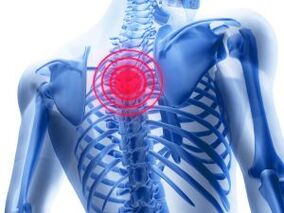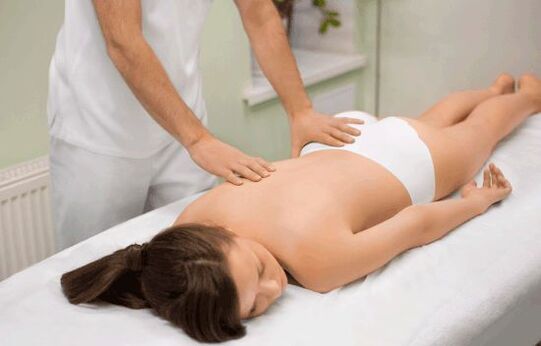
Clinically, thoracic osteochondrosis (chondrosis) is manifested by acute, piercing or dull, aching pain, cracking and clicking when bending, stiffness.
For pathology, features and many specific symptoms are a feeling of shortness of breath during inhalation, discomfort in the heart area and even a sore throat.
Pathological treatment is usually conservative with pharmacological drugs. Physiotherapy procedures, massage sessions were also performed, and chiropractors were used.
If such treatment is ineffective, the patient is indicated surgical intervention.
Details of symptoms
Symptoms of osteochondrosis of the thoracic spine never appear all at once. In the early stages of the development of this degenerative-dystrophic pathology, there is only mild discomfort in the back. The patient brings it to superficial fatigue after a day of hard work, getting rid of "numb" muscles due to long being in one body position.
But the intensity of the discomfort slowed, continued to increase. Unpleasant sensations are replaced by severe pain, complicated by limited movement, dizziness and headache. In medicine, all symptoms of localized osteochondrosis are divided into several groups. This helps diagnose it more quickly and determine treatment tactics.
On a note!The symptoms of thoracic osteochondrosis in men and women do not differ in character, severity, or localization. But in stronger sex, they can arise a little later because of the stronger musculoskeletal system. Also, some men experience erectile dysfunction against the background of osteochondrosis.
Symptoms of vertebrae
Under the influence of adverse factors (hypothermia, increased physical activity), long-term remission of chest osteochondrosis can be interrupted by a sudden onset of acute pain. More often, this is due to prolonged stay in one body position, for example, in a sitting position. If a person stands up suddenly, then there is a sharp pain in the back until he loses the ability to move for a few minutes.
In medicine, this condition is called dorsago. It differs from ordinary pain in the corresponding symptoms:
- feeling of shortness of breath during inhalation;
- severe stiffness.
The pathological course is often complicated by dorsalgia - pain in the thoracic spine, the intensity of which increases gradually. It increases by bending over, turning the body to the side. In order not to experience pain, one takes a forced position. At the same time, he inadvertently tightens his back muscles, inadvertently provoking their overtrain. Now they also start to get sick, especially when walking.
Extrvertebral symptoms
As thoracic osteochondrosis progresses, the intervertebral disc becomes thinner and destroyed. These cartilage liners are no longer able to distribute the load that arises, excluding the impact of the vertebrae on each other. The body’s compensatory response is triggered - the bone structure begins to change shape with the formation of growths. They press on the ends of sensitive nerves, breaking the spinal canal. Thus, there are specific symptoms of thoracic osteochondrosis in women and men: loss of sensitivity of certain body parts, a burning sensation and a creeping "goose bump".
Important! Osteochondrosis of the thoracic localization is often indicated by tuberculosis, unproductive, sore throat, a feeling of coma in it, as well as urinary disorders.
But that's not all. The spinal roots are responsible not only for the preservation (transmission of nerve impulses) of the spine, but also for the internal organs. Therefore, when they are violated, there is an uncomfortable sensation of the liver, kidneys, gastrointestinal tract, myocardium. What are the non-specific signs of posterior pathology indicated by thoracic osteochondrosis:
- pain in the heart area, similar to recurrent angina pectoris, shortness of breath, feeling of "compression" of the heart;
- panic attacks, psychoemotional instability, unreasonable fears, restlessness, sleep disturbances;
- discomfort in the epigastric region, attacks of nausea, sometimes causing vomiting, sour pain, bloating, something flabby and rumbling in it;
- peristalsis disorders - constipation or diarrhea;
- prolonged breath, troubled with crying.
The pain is not localized directly at the site of the destroyed intervertebral disc and (or) the formed intervertebral hernia. They radiate along the nerves. Signs of osteochondrosis of the thoracic region can be disguised as renal colic, symptoms of gastritis, gastric ulcer, hepatitis, pancreatitis, cholecystitis and even gastroenteritis.
Compression myelopathy
This is the name of extravertebral syndrome, which is rarely seen in clinical practice. It is observed at 3-4 stages of the disease, when, due to loss of stability by the vertebral segment, the nucleus pulposus protrudes beyond the annulus fibrosus. An intervertebral hernia forms, which constantly presses on the spinal cord. At an appointment with a vertebrologist or neurologist, patients complain of back pain that frequently radiates to the groin area. At the same time, there is a feeling of weakness, numbness in the lower part of the legs.
Against the background of violations of the spinal cord, the nerves are seriously disturbed. In the absence of treatment, the functional activity of organs located in the small pelvis decreases. Compression myelopathy causes problems with bowel movements. And because of the significant narrowing of the diameter of the spinal canal, the sensitivity of the foot decreases. In severe cases, patients are diagnosed with paresis (partial or complete paralysis) of one or two lower limbs.
Symptoms of remission
Outside of relapse, chest osteochondrosis hardly bothers a person. Sometimes, there is back pain, pain, dull back, which usually disappears after a long rest. But it is worth at least slightly increasing the load on the spine, lifting heavy objects or bending, as follows the subsequent recurrence. It can be triggered by factors such as:
- depressed state, depressed state;
- hypothermia, sudden temperature changes;
- prolonged stay in one body position;
- alcohol abuse;
- unbalanced diet, lack of foods high in calcium, phosphorus, manganese, molybdenum in the diet.
Sometimes the level of forgiveness ends because one person tries to avoid another relapse. He visits a chiropractor or massage therapist with a dubious reputation or little practical experience. Attempts to stretch the spine lead to other exacerbations.
The main treatment methods
It is still not possible to completely cure the pathology, so all the efforts of doctors are aimed at improving the well -being of patients. Patients are recommended to wear orthopedic products (corsets, bandages), which improve the structure of the vertebrae, preventing its displacement. Drugs from various clinical and pharmacological groups were prescribed, physiotherapeutic measures and physiotherapy exercises were carried out.

The chiropractor’s hand movements aim to increase the gap between the vertebrae, which reduces thoracic osteochondrosis.
Important!With chest osteochondrosis of high severity, conservative treatment is useless. Patients are immediately offered surgical interventions - intervertebral hernia resection, arthrodesis, placement of implants in place of damaged discs, bone grafts.
Drug therapy
Treatment of osteochondrosis of the thoracic spine aims to eliminate all symptoms, inhibition of destructive and degenerative processes. During the period of exacerbation, a solution for parenteral administration is used, which shows an effect after 5-10 minutes. Then the result is consolidated by taking a tablet preparation, using ointments and gels. At the level of remission, mainly external agents are used, which have a milder effect on the body.
Nonsteroidal anti-inflammatory drugs (NSAIDs)
This is the group of drugs most commonly used in the complex treatment of chest osteochondrosis. Their active ingredients inhibit the biosynthesis of pain, inflammation, and fever mediators from arachidonic acid. Even if only using NSAIDs, a person's well -being improves:
- the severity of the pain syndrome is reduced;
- unpleasant cramps that occur when the body rotates and tilts disappear;
- the inflammatory process in soft tissues is weakened, edema disappears;
- range of motion in the thoracic region increases.
To stop the relapse, an intramuscular solution is used. Preparations in capsules or tablets can relieve mild pain. And ointments and gels quickly eliminate discomfort.
Preparation with vitamin B
Preparations with B group vitamins can overcome nervous disorders. They increase the transmission of nerve impulses to the central and peripheral nervous systems, stimulating the recovery of damaged spinal roots. The composition of the funds is represented by thiamine, riboflavin, pyridoxine, cyanocobalamin.
In the first week of therapy, intramuscular administration is performed, which, in addition to vitamins, contains lidocaine, which immediately relieves pain. Then, for a month, the patient was shown to take the pill.
Glucocorticosteroids
The use of analogs of these synthetic hormones, produced by the adrenal glands, is practiced when safer methods are ineffective. Glucocorticosteroids are prescribed to patients with acute and stabbing back pain, radiating to internal organs. The drug can be taken orally, but is more often given parenterally, including at the site of a destroyed disc.
Glucocorticosteroids have a variety of contraindications and possible side effects. Long -term treatment of thoracic spine chondrosis with hormones leads to damage to liver, kidney, and stomach tissues. Its use is therefore prohibited in patients with cirrhosis, peptic ulcer disease, renal failure, and osteoporosis.
Relax the muscles
Back pain is often associated with increased skeletal muscle tone. To relax it, muscle relaxation is used - first in the form of a solution for parenteral administration, and then in tablet form. These medications relieve muscle spasms that cause spinal root compression. Which muscle relaxation is most effective:
- blocking polysnaptic reflexes;
- stretching spasmodic muscles;
- reduces the release of prostaglandins.
Drugs are rarely used for monotherapy. Treatment of chest chondrosis is performed with muscle relaxation in combination with glucocorticosteroids or nonsteroidal anti-inflammatory drugs. Their significant disadvantage is the relatively rapid formation of addiction, so it is forbidden to use them for more than a week.
Chondroprotectors
Unlike drugs that relieve the symptoms of chest osteochondrosis, such drugs are also used for pathogenetic therapy. This is the only group of drugs that can increase the production of chondrocytes, which are required for the partial restoration of cartilaginous intervertebral discs. All therapeutic effects of chondroprotectors are due to the high content of glucosamine and / or chondroitin.
But not just for the ability to restore discs, chondroprotectors are valued. Their components shine in the area of the damaged vertebral segment. After 2-3 weeks, maximum therapeutic concentrations of glucosamine and chondroitin were made. Now the drugs are beginning to show analgesic, anti-inflammatory, anti-edematous activity.
Recommendation!It is best to treat osteochondrosis with chondroprotectors in the form of injectable solutions or tablets. Despite all the assurances of manufacturers about the effectiveness of ointments and creams, they are unable to provide a basic evidence of the effectiveness of their therapies.
Non -drug treatment
Treatment of osteochondrosis of the thoracic region with pharmacological drugs must be combined with regular physical education. Exercise therapy is the most effective method of therapy to prevent disability. Thanks to daily exercise, the skeletal muscles of the back and the ligaments-tendons of the thoracic region are strengthened, the production of synovial fluid that feeds the vertebral structure is improved. The exercise set is determined by the exercise therapy physician after reviewing the X-ray diagnostic results. He was present in the first class, monitoring the load dose.
Manual therapy of osteochondrosis is also performed, which aims to increase the gap between the disc and the vertebrae. Dry or underwater traction (traction) of the spine is performed, and at home - hanging on the bar. The effectiveness of manual therapy is increased by performing physiotherapy simultaneously:
- electrophoresis;
- laser therapy;
- magnetotherapy;
- ultra violet radiation;
- diadynamic current.
Patients are shown 10-15 sessions of classical, vacuum, Scandinavian, acupressure. Also useful are hirudotherapy, acupuncture, spa treatments with radon and hydrogen sulfide baths.
Only with the help of an integrated approach to the treatment of thoracic osteochondrosis is it possible to exclude damage to the discs and vertebral deformities. Adhering to the doctor's recommendations helps to eliminate all symptoms of chronic pathology as soon as possible.












































